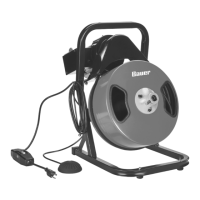Page 14 For technical questions, please call 1-888-866-5797. Item 59533 59534
SAFETY OPERATION MAINTENANCESETUP
Manual Feed Operation (For Item 59534)
TO PREVENT SERIOUS INJURY FROM TWISTED OR BROKEN CABLES, CABLE ENDS WHIPPING AROUND,
MACHINE TIPPING, CHEMICAL BURNS, INFECTIONS, ELECTRIC SHOCK AND OTHER CAUSES:
Follow operating instructions for your model explicitly.
Since drains likely contain hazardous chemicals or bacteria, wear
appropriate protective equipment, such as:
• ANSI-approved splash-resistant safety goggles and respirator under face shield.
• Latex, rubber or other liquid barrier gloves under heavy-duty LEATHER work gloves.
Do not use a glove you are not currently wearing or a rag to hold the rotating cable. Cloth materials
can tangle in the rotating cable, leading to serious personal injury. Before use, inspect gloves
to be sure they are free of defects or loose sections that could get caught in Drain Cleaner.
• Rubber soled, non-slip shoes to help prevent slipping and electric shock.
1. Position the Drain Cleaner two feet from drain.
2. Position Drain Cleaner so you can operate
Foot Switch while having one hand on
cable at all times. This will keep cable from
hazardously “whipping” when activating
Drain Cleaner. Confirm Rotation Switch on
top of Drain Cleaner is within reach.
WARNING! Only one person should feed cable
and operate Foot Switch. Do not operate
Drain Cleaner with one person controlling cable
and another person controlling Foot Switch.
This can cause cable to kink, twist, or break,
which can also lead to serious personal injury.
3. Make sure Rotation Switch is in Forward position.
4. With Drain Cleaner off, pull cable out of
drum and feed into drain. Gradually work
cable as far into drain as it will go.
5. Step on Foot Switch and continue
feeding cable into drain.
6. As you feed cable, you may feel and see
cable slow down and/or start to wind or load
up (a “twisting” or “squirming” motion). This
indicates a change in drain line (such as a drain
trap, elbow, etc.), a build up in drain (mud or
grease), or actual blockage. Continue to slowly
feed cable until cable reaches blockage.
CAUTION! Do not allow cable to build up
outside drain. This can cause cable to
twist, kink or break. When working with larger
sewers or septic tanks, minimize the amount of
cable fed to prevent kinking and knotting of cable.
7. If cable becomes lodged in a narrow part of
drain or in a drain trap, allow cable to try and
work itself past the obstruction. If cable still
won’t pass obstruction, release pressure from
Foot Switch and use sharp downward thrusts to
try and pass obstruction. Once cable is past,
press Foot Switch and continue feeding.
NOTICE
Rotation Switch controls rotation of drum only. DO NOT USE ROTATION SWITCH
REVERSE POSITION WHILE REMOVING CABLE FROM PIPE. Use reverse direction
only momentarily for relieving pressure or untangling cable from a blockage.
Warranty void if cable damaged from allowing motor to twist
excessively against blockage, or if drum is run in reverse long enough to unwind cable.

